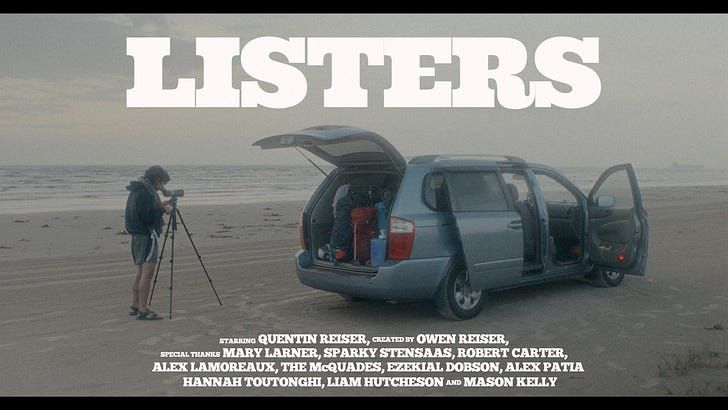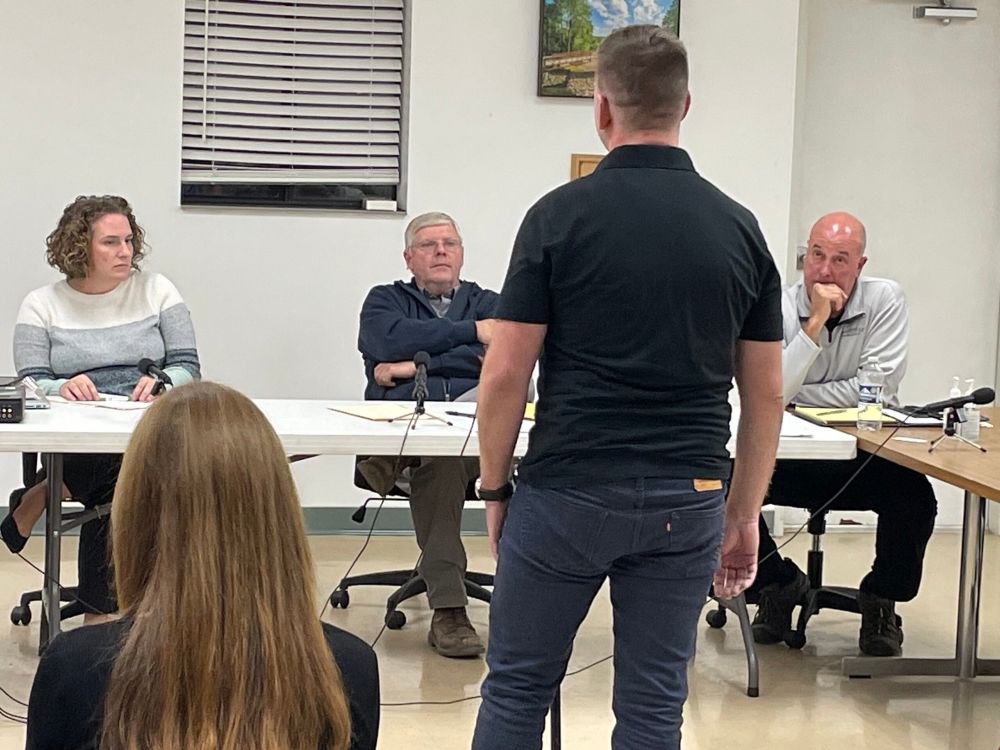LC Ohio
@lcohio.bsky.social
Funneling dread into making an edible lawn that is dog safe and pollinator friendly. Not as easy as it sounds. Ohio State Master Gardner Volunteer.
@lcohio.bsky.social
Funneling dread into making an edible lawn that is dog safe and pollinator friendly. Not as easy as it sounds. Ohio State Master Gardner Volunteer.
“The peat bogs and wetlands had been buried under nearly 25ft of dirt and gravel more than a century ago,…who would have thought that underneath meters and meters of contaminated soil…seeds and plant scraps, trapped underground for more than a century were ready to roar back to life?
10.10.2025 01:58 — 👍 4 🔁 0 💬 0 📌 0
“The Octagon Earthworks align with the 18.6-year cycle of the moon’s orbital path around the earth with unparalleled geometric precision at a scale that dwarfs the Great Pyramid of Giza…astronomical significance equivalent to Stonehenge or Machu Picchu.”
09.10.2025 22:48 — 👍 5 🔁 0 💬 0 📌 1
“The 2025 U.S. State of the Birds report reveals that we're still losing birds at an alarming rate”
For the First Time, Bird Habitats Are Evaluated and Formally Ranked in Detail

No precise upkeep. Observation and subtle intervention. Planting as a living medium shaped by structure, decay and seasonal change. 🌱
05.10.2025 15:07 — 👍 2 🔁 1 💬 0 📌 0
New Guide, great resource 🌱 Native Bee Habitat Management on Urban Farms in the Great Lakes Region https://www.canr.msu.edu/pollination/uploads/files/Native%20Bees_Habitat_Pocket%20guide.pdf The picture shows a close-up of a bee covered in bright yellow pollen as it collects food from a flower. The bee’s body is sharply detailed, showing tiny hairs, black eyes, and striped legs dusted with pollen. The background is a deep violet-purple, which makes the golden pollen and the bee’s yellow color stand out. Some soft yellow flower petals are floating nearby. Text on the image reads: “Native Bee Habitat Management on Urban Farms in the Great Lakes Region” By Jennifer Roedel, Karma Thomas, Carolyn Miller, and Zsofia Szendrei. The overall look is vibrant and high contrast, focusing on the bee’s important role in pollination.
New Guide, great resource 🌱 Native Bee Habitat Management on Urban Farms in the Great Lakes Region
www.canr.msu.edu/pollination/...

Can’t wait to watch the new birdwatching documentary Listers
(it’s on YouTube; here’s a brief description of what it is/why it’s so good)

2025, Del-Co, a Columbus-area utility, proposed buying a rural village water system, leaving residents blindsided. Now it’s drilling new wells on nearby farmland to secure millions of gallons a day. Control of water and infrastructure keeps shifting before communities understand the impact.
3/

In 2023, Granville Township trustee sold 106 acres to developer, stirring outrage over the sale’s potential impact on local water sources. Sneaky moves and rapid development raises questions about who benefits and who bears the costs.
2/
Ohio now hosts 191 data centers, including 121 around Columbus. 8 new ones in Johnstown bring Licking County’s total to 50.
Columbus is now the nation’s fastest-growing data center hub and ranks 10th in North America. 1/

. When the bog mat originally surfaced, there were no trees on it. Since then, red maples and common alders have colonized the margin of the island; their shade has adversely impacted the other bog vegetation. The most startling change has been the deteriorization of the island itself. When the island first surfaced, it was about 50 acres in size. By 1910, only 45 acres remained. By 1955, the island had deteriorated to 23 acres. In 1963, the island had lost more ground and was less than 20 acres. More than 40 years later, the island has dwindled to less than 11 acres. In all probability, Cranberry Island will continue to shrink, possibly disappearing altogether. Why is the island disappearing? The force of man, not nature, created the island. Now the forces of man and nature are combining to slowly destroy it. Unfortunately, this little island is at the mercy of severe wake and ice action coming off a very large, shallow and highly used lake. Another significant factor is that while the highly acidic stagnant waters of bog lakes typically help perpetuate the sphagnum mat, the well-oxygenated, slightly alkaline waters of Buckeye Lake allow and accelerate the natural decomposition of the mat. The waters of the man-made Buckeye Lake enable trees and marsh vegetation to invade the edges of the island where bog acid has been sufficiently diluted and oxygen is readily available. Although this dense ring of trees and shrubs has somewhat stabilized the margins of the island, it has also shaded out adjacent bog plants. Besides shading the bog vegetation, occasionally when trees are blown over, large clumps of peat clinging to the trees’ shallow root system are torn away from the island and lost. In recent years, two fairly large chunks have simply torn off and floated away. This will most likely continue as the island continues to feel the impact of natural wave action and the wakes of passing boats. Due to the fragile condition of the preserve,a no-wake zone has been posted
Unfortunately, there is no practical
way to stop the deterioration without
changing the character of the bog
environment. Just how much time
the island has before it disappears is
unknown. Cranberry Bog remains today as one of the most unique and fascinating natural areas in the nation
Love this thread. All 10 of Ohio’s bats are little brown insect (mosquito!) eaters, half are endangered or threatened
There are 2 periods which Ohioans are restricted from removing bats as directed by the Ohio Department of Natural Resources (ODNR). The next one starts 15-Oct through 31-Mar

Thursday, October 16, 2025
Woody Species Control at Cranberry Bog State Nature Preserve
10:00 am – 3:00 pm
Register: www.onapa.org
What to bring: Bring lunch, water, gloves, and muck boots. Tools will be provided.

…expanded like a giant water-logged sponge and rose 8 feet with the new water level. No longer did the floating bog mat surround the glacial lake as is typically the case with bogs. Now the lake surrounded the bog mat, the only known such occurrence of its kind in the world. 🌱4/
04.10.2025 14:01 — 👍 0 🔁 0 💬 1 📌 0… the very youngest and therefore most buoyant segment of the bog mat.
Instead of disappearing beneath the mucky waters, as did most of the adjacent swamp forest, a 50-acre upper segment of the bog mat along the north shore stretched and…3/
…the new lake was too shallow to feed the canal for barge traffic, especially during the dry season. Strangely, it was the impoundment of the swamp in 1830 which made Cranberry Bog so unique.
As the waters backed up behind the dike, all of the big swamp was inundated and destroyed, except… 2/

(One of a kind site)
Cranberry Bog State Nature Preserve
(Licking County, Ohio)
Now called Buckeye Lake, this lake was once a swamp that was to be converted into a reservoir to feed the Ohio and Erie Canal system. The plan did not work well because… /1
www.onapa.org
1803 Newark Ohio: The topography of the area was not reflected in Schenck's survey of the wide streets and plots of land around the Commons. Therefore, when the settlers arrived in town, they were probably shocked to find swamps everywhere.
www.newarkadvocate.com/story/news/h...
Gardener's pupil!
03.10.2025 22:38 — 👍 3 🔁 0 💬 0 📌 0Btw, if you’re gonna buy mums this year*, don’t. Buy asters instead. Mums are not native to N. America, asters are. Ideally one grown without pesticides but I know that’s hard to find. Any aster is better than a mum.
*if you live in N. America
Bringing these shirts back for the fall, shipping in early November 🫡
squidfacts.bigcartel.com/product/bina...

I love the Licking County Reporting Project newsletter - the nonprofit news org of Denison’s Journalism program - packed full of great local stories - how else would I have heard about this? My little swamp witch heart swoons at every pic www.thereportingproject.org/witch-please...
26.09.2025 00:03 — 👍 1 🔁 0 💬 0 📌 0
So fun to follow along with the video to see what species they find with the INaturalist app during a bioblitz in Granville, Ohio with Dr. Karen Goodall (OSU-N) and Dr. Andy McCall (Denison U)
duj24.shorthandstories.com/bioblitz/

Asters and goldenrods are blooming 🌱 each one of their small individual florets is a source of nectar and pollen, a buffet for pollinators www.izelplants.com/blog/asters-...
21.09.2025 14:39 — 👍 3 🔁 0 💬 0 📌 0
More catepillar content from Jim McCormac with a note:
“Over 1/3 of Ohio’s native plant species are officially listed as endangered, threatened, potentially threatened, or extirpated (no longer known to occur in Ohio)” jimmccormac.blogspot.com/2025/09/cate...

Some great caterpillar content from caterpillar round up with Arc of Appalachia down in Highland County, Ohio
jimmccormac.blogspot.com/2025/09/cate...
Macro stack
19.09.2025 02:01 — 👍 2 🔁 0 💬 0 📌 0
So many gems in here. Earlier springs. Later autumns 🌱
Environmental horticulturist and ecological landscape designer Kim Eierman turns climate anxiety into practical action. Learn how to design and maintain resilient, wildlife-supporting landscapes using native plants.
youtube.com/watch?v=UjlH...

Curtis Goldstein mural next to the library in downtown Newark, Ohio of six women who were Licking County residents and authors, poets and scientists. Minnie Hite Moody: author, historian, journalist. Gertrude Dorsey Brown: author. Lorinda Munson Bryant: author, educator, pharmacist. Mary Hartwell Catherwood, Lewtrah: author, poet. Ester Applin, geologist, paleontologist. Ellen Amanda Kayes, astronomer, mathematician. Part 1 of 4

Curtis Goldstein mural next to the library in downtown Newark, Ohio of six women who were Licking County residents and authors, poets and scientists. Minnie Hite Moody: author, historian, journalist. Gertrude Dorsey Brown: author. Lorinda Munson Bryant: author, educator, pharmacist. Mary Hartwell Catherwood, Lewtrah: author, poet. Ester Applin, geologist, paleontologist. Ellen Amanda Kayes, astronomer, mathematician. Part 2 of 4

Curtis Goldstein mural next to the library in downtown Newark, Ohio of six women who were Licking County residents and authors, poets and scientists. Minnie Hite Moody: author, historian, journalist. Gertrude Dorsey Brown: author. Lorinda Munson Bryant: author, educator, pharmacist. Mary Hartwell Catherwood, Lewtrah: author, poet. Ester Applin, geologist, paleontologist. Ellen Amanda Kayes, astronomer, mathematician. Part 3 of 4

Curtis Goldstein mural next to the library in downtown Newark, Ohio of six women who were Licking County residents and authors, poets and scientists. Minnie Hite Moody: author, historian, journalist. Gertrude Dorsey Brown: author. Lorinda Munson Bryant: author, educator, pharmacist. Mary Hartwell Catherwood, Lewtrah: author, poet. Ester Applin, geologist, paleontologist. Ellen Amanda Kayes, astronomer, mathematician. Part 4 of 4
Love Curtis Goldstein’s mural next to the library in downtown Newark, Ohio of six women who were Licking County residents and authors, poets and scientists.
www.msn.com/en-us/news/u...

🤔 why should I NOT go for a green roof?
www.cultivatingplace.org/post/great-g...